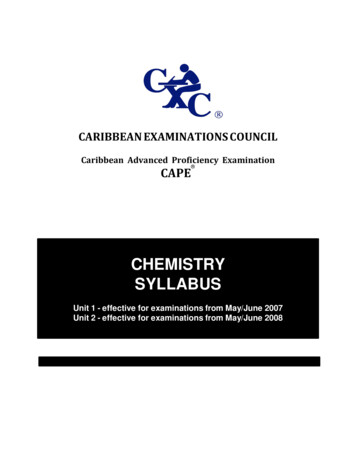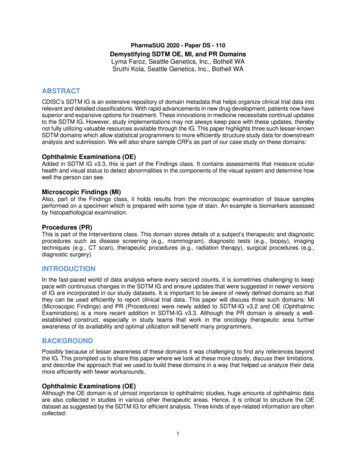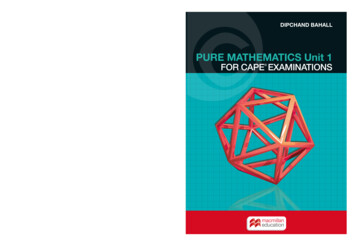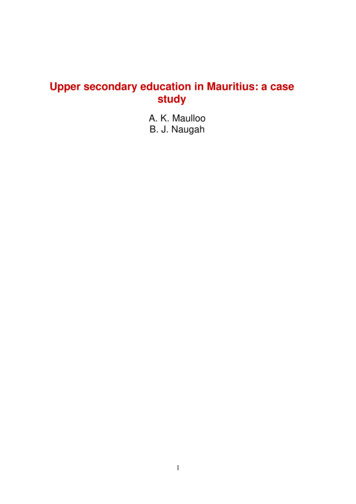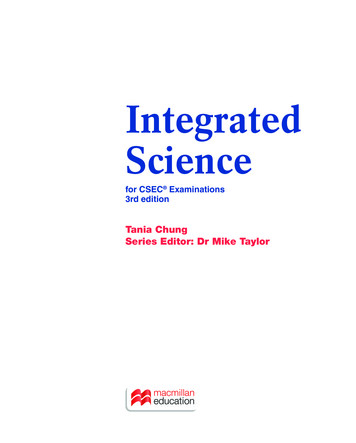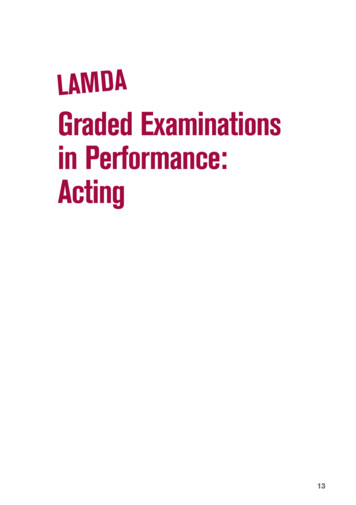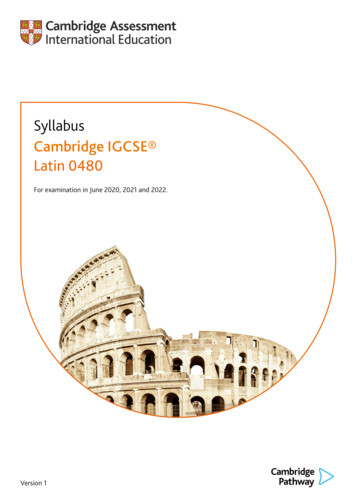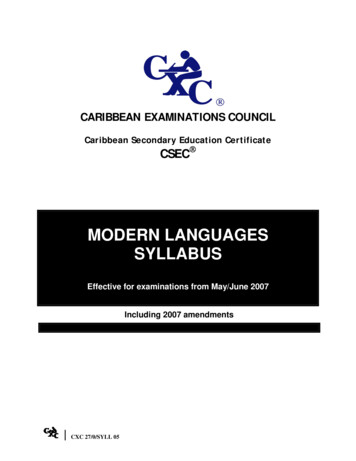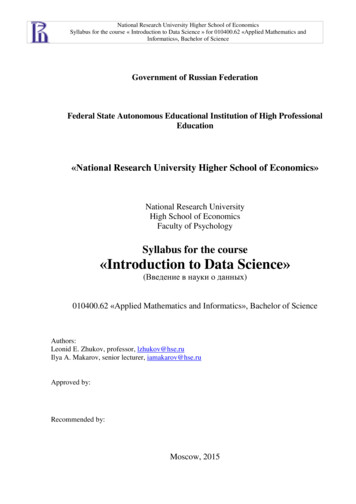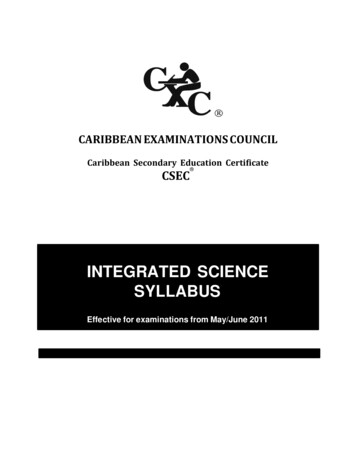
Transcription
CARIBBEAN EXAMINATIONS COUNCILCaribbean Secondary Education CertificateCSEC INTEGRATED SCIENCESYLLABUSEffective for examinations from May/June 2011CXC 23/G/SYLL 09
Published by the Caribbean Examinations CouncilAll rights reserved. No part of this publication may be reproduced, stored in a retrieval system, ortransmitted in any form, or by any means electronic, photocopying, recording or otherwise without priorpermission of the author or publisher.Correspondence related to the syllabus should be addressed to:The Pro-RegistrarCaribbean Examinations CouncilCaenwood Centre37 Arnold Road, Kingston 5, Jamaica, W.I.Telephone: (876) 630-5200Facsimile Number: (876) 967-4972E-mail address: cxcwzo@cxc.orgWebsite: www.cxc.orgCopyright 2009, by Caribbean Examinations CouncilThe Garrison, St Michael BB14038, BarbadosCXC 23/G/SYLL 09
ContentsRATIONALE .1.AIMS . 2PRE-REQUISITES OF THE SYLLABUS . 2ORGANIZATION OF THE SYLLABUS . 3CERTIFICATION AND DEFINITION OF PROFILES DIMENSIONS . 3FORMAT OF THE EXAMINATIONS . 5REGULATIONS FOR RESIT CANDIDATES . 6REGULATIONS FOR STUDENTS FROM PRIVATE INSTITUTIONS . 6SECTION A - THE ORGANISM AND ITS ENVIRONMENTUNIT I - THE CELL . 7UNIT II - FOOD AND NUTRITION . 8UNIT III - RESPIRATION/AIR POLLUTION . 10UNIT IV - TRANSPORT SYSTEMS . 11UNIT V - EXCRETION . 12UNIT VI - SENSE ORGANS AND COORDINATION . 13UNIT VII - REPRODUCTION AND GROWTH . 14SECTION B - THE HOME AND WORKPLACEUNIT I - TEMPERATURE CONTROL AND VENTILATION . 16UNIT II - THE TERRESTRIAL ENVIRONMENT . 18UNIT III - WATER AND THE AQUATIC ENVIRONMENT . 20UNIT IV - PESTS AND PARASITES/SANITATION . 22UNIT V - SAFETY HAZARDS . 23UNIT VI – METALS AND NON-METALS . 24UNIT VII – ACIDS, BASES AND MIXTURES . 26SECTION C - ENERGYUNIT I - ELECTRICITY AND LIGHTING .28UNIT II - FOSSIL FUELS AND ALTERNATIVE SOURCES OF ENERGY . 31UNIT III - MACHINES AND MOVEMENT .32UNIT IV - CONSERVATION OF ENERGY . 33UNIT V - FORCES . 34GUIDELINES FOR SCHOOL BASED ASSESSMENT . 36RESOURCES . 45GLOSSARY . 46APPENDIX I - NOTE TO TEACHERS . 51APPENDICES I (A) - I(C) - SBA RECORD BOOKS . 52APPENDIX II - SOME GUIDELINES CONCERNING PRACTICAL WORK .55APPENDIX III - SUGGESTED CHEMICALS/MATERIALS LIST . 56APPENDIX IV - SUGGESTED EQUIPMENT LIST . . 58CXC 23/G/SYLL 09
This document CXC 23/G/SYLL 09 replaces CXC 23/O/SYLL 00 issued in 2000.Please note that the syllabus was revised and amendments are indicated by italics.Issued1983Revised in 1993, 2000, 2009Please check the website, www.cxc.org for updates on CXC’s syllabuses.CXC 23/G/SYLL 09
Integrated Science Syllabus RATIONALEIn our daily lives and in society at large, many of our decisions demand a knowledge of science. Thisknowledge is necessary for dealing satisfactorily with many of the situations that confront us daily in ourhome, at the workplace and in the wider environment. Science should, therefore, be an important part ofour general education. The Integrated Science syllabus attempts to meet this need.The syllabus is based on three themes – The Organism and Its Environment, The Home andWorkplace, and Energy – chosen because, they adequately reflect the common areas of humanactivity and experience. These themes form the unifying points of the syllabus which should,therefore, be seen as a coherent unit. Integrated Science is a subject in its own right, encompassingtopics mainly from Physics, Chemistry and Biology. Indeed, if such distinctions were made, othercomponents such as Earth Sciences and Meteorology would also be recognized.The CSEC Integrated Science syllabus is designed to allow students to work individually and cooperatively,utilizing theoretical concepts of the course in interactive and practical activities. Students are expected toapply, scientific principles, investigative and problem solving skills, be effective in communicating scientificknowledge and demonstrate an appreciation for all living organisms in their environment.The Integrated Science syllabus is intended to contribute to the science education needs of Caribbean secondarylevel students in the following groups:i.those whose abilities, aptitudes and choice of courses will allow them to pursue only onescience subject, or who wish to pursue a science course in the interest of a rounded generaleducation;ii.those who study science-related subjects such as Home Economics, Physical Education andSport and Agricultural Science, or who intend to go on to studies at the tertiary level, forcareers in areas, such as, nursing and teaching.CXC 23/G/SYLL 091
AIMSThis syllabus aims to:1.develop scientifically and technologically literate students;2.develop the ability to apply scientific concepts and principles to everyday situations;3.promote a willingness to work cooperatively with others and to persist with a task to a logicalconclusion;4.increase awareness of the importance of living in harmony with the environment;5.encourage an appreciation of the need to preserve the natural environment;6.develop experimental and critical thinking skills;7.develop competencies that will enable students to make appropriate decisions regarding health, safetyand some everyday life problems. PRE-REQUISITES OF THE SYLLABUSIt is assumed that candidates would have studied Integrated Science or its equivalent up to the endof the first three years of secondary school. CSEC Mathematics and English A or their equivalentare also strongly recommended as allied subjects to be studied.Mathematical RequirementsCSEC Mathematics provides an excellent course that will support work in CSEC IntegratedScience. In particular, the areas below will be very useful.-The four basic operations ( , -, x, )-Decimals-Change of subject of simple formulae-Substituting values into simple formulae-Significant figures-Means and modes-Graphs, histograms, charts, tablesCXC 23/G/SYLL 092
Suggested Time AllocationIt is recommended that a minimum of five 40-minute periods per week over two academic years be allocated tothe study of Integrated Science syllabus. This should include at least one double period each week. Atleast two periods per week should be devoted to practicals. ORGANIZATION OF THE SYLLABUSThe syllabus is arranged in three sections sub-divided into specific objectives, correspondingexplanatory notes and suggested practical activities.SECTION A-THE ORGANISM AND ITS ENVIRONMENTSECTION B-THE HOME AND WORKPLACESECTION C-ENERGYThe arrangement of the syllabus does not necessarily represent a teaching order. Each sectionbegins with a statement of general objectives that along with the specific objectives, correspondingexplanatory notes and suggested practical activities are indicative of the content on which theexaminations will be based. However, the specific objectives should not be treated in isolation asthey are related to general objectives and syllabus aims. CERTIFICATION AND DEFINITION OF PROFILESDIMENSIONSThe subject will be examined for certification at the General Proficiency.In addition to the overall grade, there will be a profile report that reflects the candidate’sperformance of each candidate under the following headings:(i)Knowledge and Comprehension;(ii)Use of Knowledge;(iii)Practical Skills.Knowledge and Comprehension (KC)The ability to:Knowledgeidentify, recall, state basic facts, concepts and principles;Comprehensionselect appropriate ideas, match and compare and cite examples offacts, concepts and principles in familiar situations.CXC 23/G/SYLL 093
Use of Knowledge (UK)The ability to:Applicationtransform data accurately and appropriately; use commoncharacteristics as a basis for classification; use formulae accurately;Analysis and Interpretationidentify the component parts of a whole and interpret therelationships between those parts; identify casual factors andshow how they interact with each other;Synthesiscombine component parts to form a new meaningful whole; makepredictions and solve problems;Evaluationmake reasoned judgments and recommendations based on thevalue of ideas and information and their implications.P ra c t i c a l Skills (P S)The ability to:Observation/Recording/Reportinguse the senses to perceive objects and events accurately; present awritten and oral report, drawing or other graphicalrepresentation which is clear, concise, accurate and pertinent tothe investigation; report and recheck unexpected results;Drawingmake large, clear, labelled line representations of specimens,apparatus or models;Manipulation/Measurementset up and use carefully and competently simple laboratoryapparatus and measuring instruments; appropriately preparespecimens and materials for p hypotheses and devise means of carrying outinvestigations to test them; plan experimental procedures andoperations within the time allotted in appropriate sequence ofoperations as a result of difficulties encountered in carrying outexperiments or obtaining unexpected results;Analysis and Interpretationuse experimental data to infer, predict and draw conclusions;identify trends and patterns; make necessary and accuratecalculations and recognize the limitations and assumptions ofdata.Note: In addition to the P ra ct i ca l skills, candidates are expected to utilize the skills listedunder the Use of Knowledge profile dimension in their practical work.CXC 23/G/SYLL 094
FORMAT OF THE EXAMINATIONSPap e r 01Sixty multiple-choice items drawn from all areas of the syllabus.Pap e r 02Part AFour compulsory structured questions drawn from all areas of the syllabus.Question 1 will be a practical/investigative type question.(1 hour 15 minutes)(2 hours)Part BTwo compulsory essay type questions.Pap e r 03/1The School Based Assessment will evaluate the achievement of thecandidates in the Practical Skills in the laboratory and field work.Candidates will be required to keep a laboratory notebook. CXC willrequire a sample of laboratory notebooks for external moderation. Astatement of the tasks set for SBA and the corresponding Mark Schemesused should accompany these. See Guidelines for SchoolBasedAssessment on pages 36-44.Pa p e r 0 3 / 2(School Based AssessmentFor private candidatesonly)Alternative to the School Based Assessment for private candidates. The paperwill examine the same skills as these tested on Paper 03/1. The focus, therefore,will be on Practical skills and consist of three written questions.School Based Assessment(2 hours)TABLE 1ALLOCATION OF MARKS ACROSS PAPERS AND PROFILE DIMENSIONSPROF I L E SKnowledge andComprehension (KC)Use of Knowledge (UK)Practical Skills (PS)To t a l %CXC 23/G/SYLL 09PAPE R01PAPE R02SB A03TO TA L3017-47-29-29-420243050201005
REGULATIONS FOR RESIT CANDIDATES1.Resit candidates must complete Papers 01 and 02 of the examination for the year for which they reregister. Resit candidates who have earned 50% of the MO D E R A T E D score for the SBAcomponent may elect not to repeat this component, provided they re-write the examination no laterthan the year following their first attempt. The scores for the SBA can be transferred once only - thatis, to the examination immediately following that for which they were obtained.2.Resit candidates who have obtained less than 50% of the MO D E R A T E D scores for the SBAcomponent must repeat the component at any subsequent sitting.3.Resit candidates must be entered through a school or other approved educational institution. REGULATIONS FOR STUDENTS FROM PRIVATEINSTITUTIONS1.Private candidates must be entered through institutions recognized by the Council.2.Private candidates will be required to complete all aspects of the examination (Papers 01, 02 and03).3.The SBA activities of private candidates must be monitored by tutors in the institution throughwhich they register.4.Private candidates must submit their own work, which must be validated by their tutors.CXC 23/G/SYLL 096
SECTION A - THE ORGANISM AND ITS ENVIRONMENTGENERAL OBJECTIVESOn completion of this Section, students should:1.understand that cells are the basic unit of life;2.develop an appreciation for the interdependence of life processes;3.understand the relationship between the organism and its environment;4.understand the relationship between the structures and functions of the systems within an organism;5.develop investigative and problem solving skills.UNIT I – THE CELLSPECIFIC OBJECTIVESEXPLANATORY NOTESSUGGESTED PRACTICALACTIVITIESStudents should be able to:1. draw simple diagrams toshow the structure ofunspecialized plant andanimal cells;Cell wall, cell membrane, nucleus, Construct models using plasticinecytoplasm, vacuoles, mitochondria, or other materials found aroundchloroplast. Details of structures the home or laboratory.as seen in electron micrographs notrequired.2. explain the importance of thecell wall, cell membrane,nucleus, chromosomes,cytoplasm, mitochondria,vacuoles and chloroplast;Simple treatment only, forexample, chromosomes carrygenetic information in the form ofDNA.3. explain the processes ofdiffusion and osmosisusing an experimentalapproach.Importance of diffusion andosmosis in transporting substancesin and out of cells and from onecell to another in all livingorganisms. Reference to the cellmembrane as a partially permeablemembrane.CXC 23/G/SYLL 097Carry out simple investigations toillustrate the movement of particles(molecules and ions)
UNIT II – FOOD AND NUTRITIONSPECIFIC OBJECTIVESEXPLANATORY NOTESSUGGESTED PRACTICALACTIVITIESStudents should be able to:Experimentstoestablishconditions for photosynthesis,tests for starch as a product ofphotosynthesis.1. describe the process ofphotosynthesis;Definition, identificationofsubstrate,conditionsandproducts; word and chemicalequations; outline of process;importanceoflight,chlorophyll, carbon dioxide andawareness that light energycan be converted to chemicalenergy.2. describe photochemicalreactions;Refer to photosynthesis andphotography.3. explain the importance offood;The Caribbean food groups, their Food tests.sources and functions of their mainnutrients.Collect food labels to discernnutritive content.Discussion of food additives andtheir effect on health; balanced and Experiments to measure energyunbalanced diets. Balanced diet value of food.related to age, gender, occupation;deficiency diseases (PEM) obesity.4. discussspecifictimingphysicaldietary needs foractivities and theof meals prior toactivities;5. explain the process ofdigestion in human beings;CXC 23/G/SYLL 09Mechanicalanddigestion; role ofenzymes active atstages, substrates andabsorption, estion.Draw and label the digestivesystem in human beings andstate the function of each part;identify enzymes, digestive juicesand state of acidity/alkalinity ateach stage; experiments to showeffects of temperature and pHon enzymes.
UNIT II – FOOD AND NUTRITION (cont’d)SPECIFIC OBJECTIVESEXPLANATORY NOTESSUGGESTED PRACTICALACTIVITIESStudents should be able to:6. explain the role of teeth indigestion.CXC 23/G/SYLL 09Types of teeth/dental formula; Draw and label a diagram of arelate structures to function; vertical section of a tooth;examine models of individualEffect of fluoridation.teeth.9
UNIT III – RESPIRATION/AIR POLLUTIONSPECIFIC OBJECTIVESEXPLANATORY NOTESSUGGESTED PRACTICALACTIVITIESStudents should be able to:1. explain the mechanism ofbreathing;Inhalation/exhalation, pressure andvolume changes, role of ribcage anddiaphragm: composition of inhaledand exhaled air.Bell jar experiment.Ventilator or ventilator machine Consider the use of technology clips- video, DVD, CD’s flash drives.2. distinguish between gaseousexchange and breathing;Structure of lungs and alveoli.Diagrams.3. discuss the importance ofrespiration to organisms;Definition, substrate and products, Experiments to show release ofword and chemical equation; site, energy and carbon dioxide bytypes and importance of energy organisms.release; energy related to typeof substrate.4. compare and contrast aerobicand anaerobic respiration;Types - compare amounts ofenergy produced, products anduse;importanceofanaerobicrespiration [sports/industries].5. discuss the features commonto respiratory surfaces;Including how fishesoxygen from water.6. identify the causes of airpollution;Sulphur dioxide, carbon dioxide,methane, carbon monoxide, lead;obtain- afinity of carbon monoxide tohaemoglobin of red blood cells.7. discuss ailments thatcaused by air pollution;are8. explain the effects of smokingon the respiratory system.CXC 23/G/SYLL 09Allergies, lung cancer, otherrespiratory disorders.Importance ofenvironments.smoke10freeCollect newspaper clippings, makehistograms.
UNIT IV – TRANSPORT SYSTEMSSPECIFIC OBJECTIVESEXPLANATORY NOTESSUGGESTED PRACTICALACTIVITIESCirculatory system: necessity,surface area/volume ratio;transport in plantstranspiration, movement ofnutrients, structure of stem –xylem/phloem.Experiments on diffusion withagar cubes of different sizes toshow how surface area/volumeratio affects total diffusion.Students should be able to:1. discuss the need fortransport systems withina living organism;[Refer to Unit I, SpecificObjective 3].2. relate the structures ofthe circulatorysystemin human beings to theirfunctions;Composition of blood and types ofblood cells and their functions;blood vessels and their functions,structure of the heart and heartbeat; names of major bloodvessels associated with theheart only.3. identify the blood groups;A, B, ABantibodyprecautionhandling;pregnancy4. explain the role of antigensand antibodies in natural andartificial control of diseases;Vaccines; an awareness of AIDS Research on the effect ofas a disease which results from retrovirals on person’s living withdamages to the immune system.HIV/AIDS.andforinRhandO: antigen and Use information gathered fromeach group, clinics, hospitals and doctors.transfusion andfactor- risk inprecautions.5. explain possible causes ofhypertensionandheartattacks;6. discuss the physiologicaleffects of exercise;Effectsoncirculatoryandrespiratory systems, effects onbalancing energy input and output.7. discuss the effects and ethicsof using drugs and othertechniques in theperformance enhancement ofathletes.Blood doping to increase thenumber of red blood cells; use ofhormones (steroid); diet andtraining programs.CXC 23/G/SYLL 0911Research and report on use andmis-use of drugs.
UNIT V - EXCRETIONSPECIFIC OBJECTIVESEXPLANATORY NOTESSUGGESTED PRACTICALACTIVITIESStudents should be able to:1. distinguishbetweenexcretion and egestion;Definitions. [Refer to Unit II,Specific Objective 5].2. explain the mechanism ofexcretion by the lungs,skin and kidneys;Relationship to metabolism, Examine cross sectionexcretory organs and products; diagrams/models of the skinkidney - structure of tubule and kidneys of human beings.relatedtoultra-filtration(dialysis) and re-absorption;Osmoregulatory function of kidneys;dialysis. Relate structure of skin toits function.[Refer to UnitObjective 2].3. identifythewasteproductsoffloweringplants and their methodsof excretion.CXC 23/G/SYLL 09III,SpecificWaste products of respirationand photosynthesis only.Osmoregulation related toenvironmental factors; plants waste products, gaseous exchangeand its importance, leaffall/storage in bark.12
UNIT VI – SENSE ORGANS AND COORDINATIONSPECIFIC OBJECTIVESEXPLANATORY NOTESSUGGESTED PRACTICALACTIVITIESStudents should be able to:1. describe thestructuresand functions of thenervous system;Brain, sensory and motor neurone. SimplifiedFeatures (receptors, control, effects). structuresVoluntary and involuntary actions. neurones.diagrams showingofbrainandAn understanding that nerves Simple reflex arc, for example,carry messages using chemical and knee jerk.electrical energy; identification oftheeffectsofthemalfunctioning of the system,for example, paralysis.2. describe the functions ofthe endocrine system;Endocrine - hormones as Structural diagram – identifymessengers; thyroid, pancreas, location of organs; list hormonessex organs, adrenal glands and produced and their uses/effects.pituitary glands.3. explain how life processesare regulated by feedbackcontrol;Ectothermic and endothermicanimals;advantagesofendothermy; feedback control set range of values, detection ofdeviation and response.4. relate the structures of themammalianeyetotheir functions;Accommodation and control ofamount of light entering eye.5. explain sight defectstheir corrections;andLong and short sightedness; effects Carry out simple investigationsof bright light, ultra violet light using convex and concave lenses.and physical injury; function ofconvex and concave lenses.6. relate the structures of themammalian ear to theirfunctions.Theapproximateaudio Carry out simple investigations onfrequency spectrum of the pitch and loudness.human ear; the effects ofloudness and pitch on humanbeings.CXC 23/G/SYLL 0913Use a flow chart to illustrate theconcept of the feedback mechanism;illustrate using temperature controland osmoregulation.Compare a model of the eye witha camera. (Pin hole)
UNIT VII – REPRODUCTION AND GROWTHSPECIFIC OBJECTIVESEXPLANATORY NOTESSUGGESTED PRACTICALACTIVITIESStudents should be able to:1. ple cell division - Details of meiosis andmitosis not required. Comparison ofasexual andsexualreproduction,advantages and disadvantages of asexualreproduction (variety, evolution, livestockand crops).Examine and draw storageorgansincludingcorms,bulbs, rhizomes, runners, andcuttings. Drawing of halfflower, fruits and seeds.Use models/charts of humanreproductive system.2. describevariousmethods of asexualreproduction in plantsand animals;Budding, cuttings, runners, tissue culture,cloning, grafting.3. describe the process ofsexual reproduction inplants and in humanbeings;Flowers: name and functions of parts;pollination: types, advantages of crosspollination, agents of; fertilization anddevelopment of seeds/fruits (outline);human reproductive system: names andfunction of parts.4. describe the menstrualcycle;Roles of estrogen and progesterone; mentionmenopause.Simplifieddiagramsillustrate processes.5. discuss ovulation,fertilization,implantation,development of thefoetus and birth;6. discuss the advantagesand disadvantages ofvarious methods of birthcontrol;CXC 23/G/SYLL 09Natural, barrier, hormonal, surgical.14to
UNIT VII – REPRODUCTION AND GROWTH (cont’d)SPECIFIC OBJECTIVESEXPLANATORY NOTESSUGGESTED PRACTICALACTIVITIESStudents should be able to:The effects of nutrition, drugs, Collect data from health centre or otherx- rays and diseases; advantages of health facilities.breastfeeding, and immunization.7. discuss the importanceof pre and post natalcare of mothers andbabies;The implications of thefactor. [Refer to UnitSpecific Objective 3].8.discuss the causes,symptoms, preventionandcontrolofsexually transmittedinfections [STI’s];Herpes, Gonorrhea,Hepatitis, AIDS;Syphilis,Bacterial - Syphilis orGonorrhea;Viral - Herpes; FungalCandida.[Refer to UnitObjective 4].compare growthpatterns inselectedoganisms;10. discuss theneed for humanpopulationcontrol.CXC 23/G/SYLL 09RhIV,Use charts/tables compare information ofSTI’s.–IV, SpecificSeeds of annual plants - Plot graph of plant growth at regularbalsam, bean and corn (maize). intervals of one week and extrapolateto predict height at futuretime;Germination in plants.construct and analyze graphs of heightand weight with increase in age of boysand girls; attempt to verify predictionfor plants and human beings.Effects of population pressures Collect population statistics fromon quality of life, world food agencies, such as, WHO and UNESCO,productionandlimited as well as Internet sources.materialresources;consideration of the effects ofteenagepregnancy;birthcontrol methods.15
SECTION B - THE HOME AND WORKPLACEGENERAL OBJECTIVESOn completion of this Section, students should:1.appreciate that the soil and the sea are the two most important outdoor working environments in theCaribbean;2.understand the relationship between human beings and the environment in which they work;3.understand the need for appropriate physical conditions, such as, ventilation and sanitation inthe home and the workplace;4.understand the occurrence of accidents, hazardous situations and safety measures used in theirprevention;5.develop investigative and problem solving skills.UNIT I – TEMPERATURE CONTROL AND VENTILATIONSPECIFIC OBJECTIVESEXPLANATORY NOTESSUGGESTED PRACTICALACTIVITIES1. describe the methods ofheat transfer and theirapplications;Conduction, convection, radiation.Mention land and sea breezes.Perform simple experiments.2. explain the principle es operate;Electrical and gas ovens, electricalirons.Demonstration to illustrate theprinciple using a bimetallic strip.3. describe the features ofthermometers and theprinciples by which theywork;Types of thermometers, for Perform simple experiments toexample,clinical,laboratory, demonstrate use. Safe handlingdigital, minimum and maximum techniques should be encouraged.thermometers, alcohol and mercurythermometers.4. explain the cooling effectof evaporation;Latent heat of vaporization,sweating and metabolic rate.Students should be able to:CXC 23/G/SYLL 0916
UNIT I – TEMPERATURE CONTROL AND VENTILATION (cont’d)SPECIFIC OBJECTIVESEXPLANATORY NOTESSUGGESTED PRACTICALACTIVITIES5. explain the effects oftemperature and relativehumidityonbodyfunctions;Physiological effects of exposure tothe sun.Investigate the effects of wind,temperature and humidity ofthe area on evaporation anddrying of materials.6. explain the need for properventilation.Effects of ventilation. Include airconditioner and humidifier.Identify features of buildingswhich promote ventilation.Students should be able to:CXC 23/G/SYLL 0917
UNIT II – THE TERRESTRIAL ENVIRONMENTSPECIFIC OBJECTIVESEXPLANATORY NOTESSUGGESTED PRACTICALACTIVITIESStudents should be able to:1. discuss the factors whichinfluence soil formation;Physicalweatheringaction.2. compare the typesfunctions of soils;Sand, loam and clay; drainage,air content.andandandchemicalbiological3. relate soil fertility
The Integrated Science syllabus is intended to contribute to the science education needs of Caribbean secondary level students in the following groups: i. those whose abilities, aptitudes and choice of courses will allow them to pursue only one science subject, or who wish to pursue a science course in the interest of a rounded general

